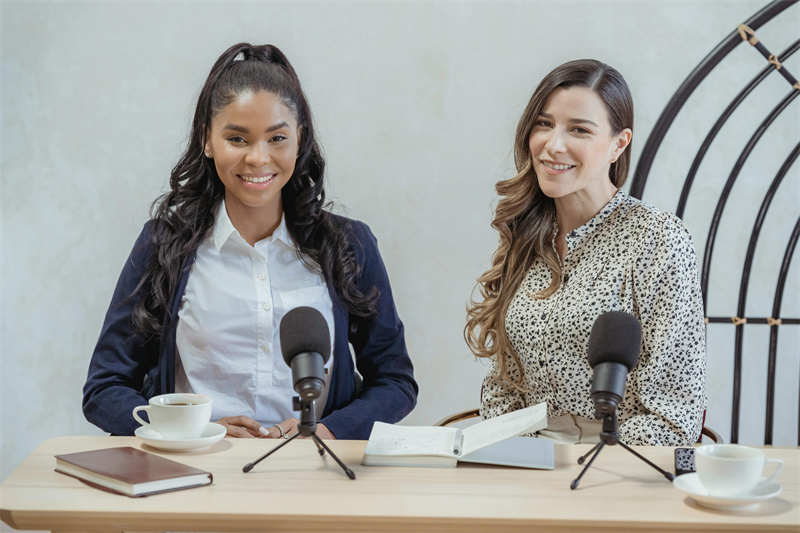The Best Podcast Microphones You Shouldn’t Miss in 2025

There's a lot that goes into making a podcast, but nothing matters more than how you sound. Your microphone is what carries your voice to the listener, whether you're flying solo, chatting with a co-host, or hosting guests. In a growing sea of podcasts, clean, professional audio can be the difference between gaining loyal listeners or losing them in the first few seconds.
In this article, we'll walk you through how to choose the right podcast microphone and share top recommendations to match every style and budget.
Part 1: How to Choose the Right Podcast Microphone
1. Microphone Type: Dynamic Vs Condenser
- Dynamic Microphones:
Dynamic mics are tough and do a good job of blocking out background noise. That makes them great for recording at home or in rooms that aren't soundproofed. They're not overly sensitive, so your voice stays in focus, even if there's traffic outside or a fan running nearby.
- Condenser Microphones:
Condenser mics are more detailed and responsive, making them a go-to for studio-quality recordings. But they also tend to pick up every little noise, which means they work best in treated or isolated spaces.
Quick tip: If you're recording at home, go with a dynamic mic. Save the condenser for a sound-treated setup where you can control the noise.
2. Connection Type: USB Vs XLR
- USB Microphones:
USB mics are plug-and-play, perfect for beginners and solo podcasters. Since no additional gear is needed, you just have to connect to your laptop and start recording.
- XLR Microphones:
XLR mics require an audio interface or mixer but provide better control over audio quality. They're ideal for multi-mic setups or professionals who want greater flexibility.
Note: Go for USB if you're just starting or need a simple setup. Choose XLR if you're building a professional podcast studio.
3. Microphone Budget
Microphones range from under $50 to over $500. Beginners can find quality budget mics, while pros might invest in studio-grade options. Spend according to your needs, but don't overlook sound quality.
4. Microphone Sound Quality
Look for a balanced frequency response and low self-noise. A good podcast microphone should make your voice sound natural and not overly processed or tinny.
5. Other Factors to Consider
Here are some other factors that you can consider:
-
- Mounting Options: Does the mic come with a stand or require a boom arm?
- Built-in Pop Filter: Reduces plosives like "P" and "B" sounds.
- Software Integration: Some mics offer companion software for EQ and sound shaping.
Bonus: The Best Podcast Camera - OBSBOT Tail 2 Live Production Camera
If you're looking for a podcast camera, the OBSBOT Tail 2 actively enhances your production flow. Acting like a silent co-host, it tracks your movement, adjusts framing in real time, and eliminates the need for a camera operator, all while keeping your focus exactly where it should be. This means you can focus on your delivery while the camera does the visual storytelling.
Whether you're hosting solo, interviewing remotely, or recording in a casual setup, it ensures your video quality matches the professionalism of your podcast microphone.
OBSBOT Tail 2 Key Features for Podcasters:
- 4K@60fps Resolution & 1080p@120fps Option: Provides ultra-high-definition video with smooth motion, giving your podcast a polished, professional look that stands out on any platform.
- All-Pixel Phase Detection Auto Focus (PDAF): Offers fast and precise focusing across the entire frame, ensuring that you stay crisp and clear even if you move slightly.
- 3-Axis Gimbal Stabilization: Delivers ultra-smooth video, keeping your footage stable even if you're moving or gesturing during your podcast recording.
- AI Tracking with "Only Me" Mode & Gesture Control: Automatically follows you as you speak or move, giving you freedom to express naturally while staying in frame.
- HDMI, USB, NDI HX3, and MicroSD Support: Offers flexible connectivity for live streaming, local recording, or multi-platform broadcasting — perfect for podcasts with video formats.
Part 2: The Best Podcast Microphones
Budget-friendly Podcast Microphone
1. Samson Q2U - $69.99

The Samson Q2U is a favorite among beginner podcasters because it's easy to use, sounds professional, and grows with you. Its dynamic capsule helps reduce background noise, making it great for home setups, while the dual USB/XLR output means you can start simple and later upgrade to a full audio interface without replacing your mic.
- Microphone Type: Dynamic
- Connection Type: USB & XLR
Best for:
Beginner podcasters recording at home who want quality audio with flexibility for future upgrades.
2. FIFINE AMPLIGAME AM8 - $54.99

The FIFINE AMPLIGAME AM8 brings style and sound together, offering vibrant RGB lighting and a noise-rejecting dynamic build, which is perfect for podcast creators who care about both looks and performance. With both USB and XLR ports, it suits new podcasters and those transitioning to pro setups alike.
- Microphone Type: Dynamic
- Connection Type: USB & XLR
Best for: Creators looking for an affordable podcast microphone that offers visual flair and professional-grade flexibility.
3. MAONO AU-AO4 - $49.99

The MAONO AU-A04 is one of the best cheap podcast mics for beginners who want crisp sound without dealing with mixers or interfaces. Its condenser capsule captures vocal detail well, which is ideal if you're podcasting in a quiet room or studio-like setup.
- Microphone Type: Condenser
- Connection Type: USB
Best For: First-time podcasters with a quiet recording space who want plug-and-play ease and clean sound.
Mid-range Podcast Microphone
Blue Yeti X - $99.99

The Blue Yeti X is a popular all-in-one solution for podcasters who want great sound and real-time control without complex gear. With multiple pickup patterns, including cardioid, omnidirectional, and bidirectional, it's ideal for solo episodes, interviews, or roundtable discussions. The built-in LED metering and gain control let you monitor your levels as you record.
Microphone Type: Condenser
Connection Type: USB
Best For: Podcasters who seek versatility for solo and guest episodes with easy USB setup and onboard controls.
HyperX QuadCast S - $159.99

The HyperX QuadCast S stands out with its eye-catching RGB design, but it's more than just looks. Its anti-vibration shock mount, built-in pop filter, and multiple polar patterns make it an excellent pick for podcasters who want broadcast-style sound without a mixer. The tap-to-mute sensor is especially handy for live streaming or podcasting in real-time.
Microphone Pickup Type: Condenser
Connection Type: USB
Best For: Podcasters and streamers who want a plug-and-play mic with strong vocal clarity and modern design.
Rode NT1 Signature - $159

The Rode NT1 Signature delivers warm, natural vocal tones with ultra-low self-noise, making it a go-to for podcasters recording in treated rooms. Its XLR-only output means it's best used with an audio interface, but the result is studio-grade audio that makes spoken content sound cinematic.
Microphone Type: Condenser
Connection Type: XLR
Best For: Serious podcasters using XLR setups who prioritize detailed, professional sound quality.
Pro-level Podcast Microphone
Shure MV7- $299

The Shure MV7 brings studio-quality sound in a podcaster-friendly form. Inspired by the legendary SM7B, this mic offers USB convenience for quick setups and XLR output for pro workflows. Its dynamic design is great for untreated spaces, while built-in voice isolation helps you sound focused and rich without needing much post-editing.
Microphone Type: Dynamic
Connection Type: USB & XLR
Best For: Professional podcasters who want the flexibility of USB and XLR in one mic, with sound that's consistently clean across all setups.
BEACN Mic - $299.99

Microphone Pickup Type: Dynamic
Connection Type: USB
The BEACN Mic is built with creators in mind, combining pristine dynamic audio with intuitive software control. It features onboard DSP for compression, EQ, and noise reduction without any interface. Its modern design and real-time tuning options make it ideal for creators who want total control over their voice tone without external gear.
Best For: Tech-savvy podcasters who want a sleek, modern mic with broadcast sound and customizable software control.
Electro-Voice RE20 - $449

A true broadcast legend, the Electro-Voice RE20 has been the gold standard in radio and voiceover for decades. Its variable-D design prevents tonal shifts when you move, and it handles plosives, background hum, and bass with professional precision.
Microphone Pickup Type: Dynamic
Connection Type: XLR
Best For: High-end podcast studios or creators who want unmatched vocal consistency and radio-grade audio.
Part 3: FAQs about Podcast Microphone
1. What type of mic is best for podcasting?
Dynamic microphones are usually best for podcasting, especially in untreated rooms, as they block background noise and focus on your voice.
2. Do podcasters use dynamic or condenser mics?
Both are used, but dynamic mics are more common due to their noise rejection. Condenser mics work better in studio environments.
3. What basic equipment do I need to start a podcast?
You'll need a podcast microphone, headphones, and recording software. An audio interface is required if you're using an XLR mic.
4. How much does a basic podcast setup cost?
A beginner setup can cost under $100, while professional podcasting gear can go up to $500 or more, depending on your needs.
Conclusion
Along with improving sound quality, the right podcast microphone shapes how your voice is heard and remembered. Whether you're starting on a budget or building a pro studio, there's a mic that fits your style, setup, and goals. Pair it with a smart video solution like the OBSBOT Tail 2, and you're ready to create podcasts that look and sound truly professional.















